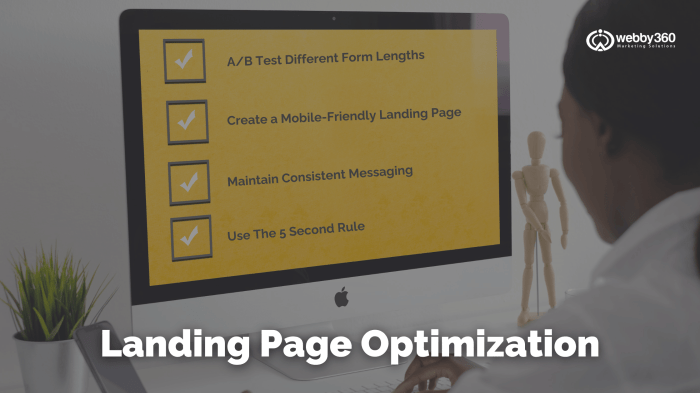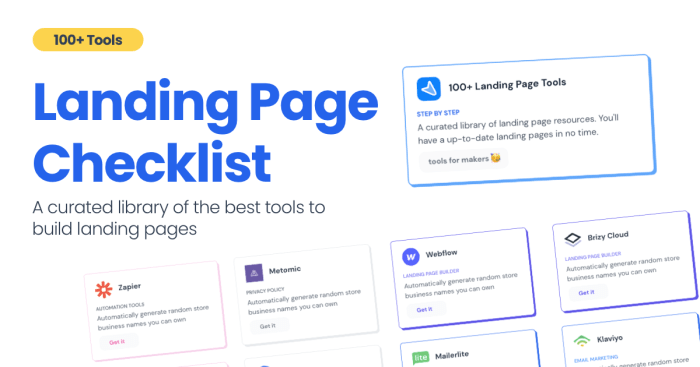Creating a Landing Page Optimization Checklist takes center stage in the digital arena, where businesses strive for online success. Dive into the world of optimization and discover the key elements that can skyrocket your conversion rates. Get ready to elevate your landing page game to new heights!
Understanding Landing Page Optimization

When we talk about landing page optimization, we’re referring to the process of improving various elements on a landing page to increase conversions or achieve specific business goals. This includes tweaking design, content, and functionality to make the page more appealing and user-friendly.
Importance for Businesses
Landing page optimization is crucial for businesses because it directly impacts the success of marketing campaigns. A well-optimized landing page can significantly improve conversion rates, generate more leads, and ultimately increase sales. It also helps in improving the overall user experience, which can lead to better customer satisfaction and loyalty.
Benefits of Well-Optimized Landing Page
- Increased Conversions: By optimizing your landing page, you can make it more compelling and engaging, leading to higher conversion rates.
- Improved User Experience: A well-optimized landing page provides a seamless and user-friendly experience, making it easier for visitors to navigate and take desired actions.
- Higher ROI: With better conversion rates, businesses can achieve a higher return on investment (ROI) from their marketing efforts.
- Enhanced Credibility: An optimized landing page reflects professionalism and attention to detail, which can enhance the credibility of your brand.
- Better Data Insights: By testing and optimizing different elements on your landing page, you can gather valuable data insights that can help you make informed decisions for future campaigns.
Components of a Landing Page Optimization Checklist
To ensure that your landing page is optimized for maximum conversions, it is crucial to have a comprehensive checklist that covers all essential components. Each element plays a vital role in creating a successful landing page that attracts and engages visitors effectively.
Clear and Compelling Headline
A catchy headline is the first thing visitors see when they land on your page. It should be concise, attention-grabbing, and relevant to what you’re offering. A compelling headline can entice visitors to stay on your page and explore further.
Strong Call-to-Action (CTA)
A clear and prominent call-to-action button guides visitors on what action to take next, such as signing up for a newsletter, making a purchase, or requesting a demo. The CTA should stand out, use actionable language, and create a sense of urgency.
Engaging Visuals
High-quality images, videos, or graphics can enhance the overall look and feel of your landing page. Visuals help grab attention, convey your message effectively, and create a memorable experience for visitors.
Concise and Persuasive Copy
Well-crafted copy that highlights the benefits of your product or service can persuade visitors to take action. The content should be clear, concise, and focused on addressing the needs and pain points of your target audience.
Social Proof and Testimonials
Including testimonials, reviews, or social proof from satisfied customers can build trust and credibility. Positive feedback from others can reassure visitors and encourage them to engage with your brand.
Mobile Responsiveness
With a significant portion of internet traffic coming from mobile devices, it’s essential to ensure your landing page is optimized for mobile users. A responsive design ensures a seamless experience across different screen sizes and devices.
Performance Tracking and Analytics
Integrating tracking tools like Google Analytics allows you to monitor the performance of your landing page, track user behavior, and make data-driven decisions for optimization. Analytics provide valuable insights into what’s working and what needs improvement.
Examples of successful landing pages that incorporate these components include Dropbox, Slack, and Airbnb. These brands effectively use clear headlines, compelling CTAs, engaging visuals, persuasive copy, social proof, mobile responsiveness, and analytics to create high-converting landing pages that drive results.
Design and Layout Considerations
When it comes to creating a killer landing page, design and layout play a crucial role in grabbing the user’s attention and guiding them towards the desired action. A well-thought-out design can make or break the success of your landing page.
Impact of Design on Landing Page Effectiveness
- First impressions matter: A visually appealing design can immediately capture the user’s interest and encourage them to explore further.
- Consistent branding: Ensure that your landing page design aligns with your brand identity to maintain a cohesive user experience.
- Clutter-free layout: Keep the design clean and organized to prevent distractions and help users focus on the key message and call-to-action.
Optimizing Layout for User Experience
- Clear hierarchy: Use visual hierarchy to prioritize important elements and guide users towards the desired action.
- Whitespace utilization: Incorporate ample whitespace to enhance readability and prevent visual overload.
- Responsive design: Ensure your landing page is optimized for various devices to provide a seamless user experience across all platforms.
Role of Call-to-Action Buttons in Design
- Strategic placement: Position your call-to-action buttons prominently on the page where they are easily accessible and stand out.
- Color and contrast: Use contrasting colors for your call-to-action buttons to make them visually distinct and compelling.
- Compelling copy: Craft persuasive and action-oriented copy on your buttons to entice users to take the desired action.
Content Optimization Strategies

Content is a key component of any landing page as it has the power to persuade and engage visitors. Compelling copy can make a significant impact on conversion rates and overall success of the page. Here are some strategies to optimize your content:
Importance of Compelling Copy
Creating persuasive headlines and content is crucial in capturing the attention of your visitors and encouraging them to take action. Compelling copy should be clear, concise, and relevant to the audience you are targeting. It should address the pain points of the visitors and offer a solution that resonates with them.
- Use strong and action-oriented language to create a sense of urgency.
- Highlight the benefits of your product or service to show visitors what’s in it for them.
- Include social proof, such as testimonials or reviews, to build credibility and trust.
Creating Persuasive Headlines and Content
The headline is the first thing visitors see when they land on your page, so it needs to be attention-grabbing and compelling. Here are some tips for creating persuasive headlines and content:
- Keep it concise and to the point.
- Use power words that evoke emotion and curiosity.
- Make it specific and relevant to the visitor’s needs.
Use of Visuals and Multimedia
Incorporating visuals and multimedia can enhance the overall user experience and make your content more engaging. Visual elements such as images, videos, infographics, and animations can help convey your message effectively and capture the attention of visitors.
Remember to optimize your visual content for fast loading times to prevent slow page speeds, which can negatively impact user experience and conversion rates.
Mobile Responsiveness and Page Speed: Creating A Landing Page Optimization Checklist
In today’s digital age, where most users access the internet through their mobile devices, having a mobile-responsive landing page is crucial for the success of any online marketing campaign. Mobile responsiveness ensures that your landing page looks and functions seamlessly across various devices, including smartphones and tablets. This not only provides a better user experience but also helps in improving your search engine rankings.
Optimizing Landing Pages for Various Devices
When optimizing your landing page for mobile devices, consider the following:
- Use a responsive design that adapts to different screen sizes and resolutions.
- Optimize images and videos for faster loading times on mobile devices.
- Ensure that all buttons and links are easily clickable on touch screens.
- Keep the content concise and to the point, as mobile users tend to have shorter attention spans.
- Test your landing page on different devices to ensure consistent performance.
Impact of Page Speed on User Engagement and Conversions
Page speed plays a crucial role in user engagement and conversion rates. A slow-loading landing page can lead to high bounce rates and lower conversions. Users expect instant access to information, and if your page takes too long to load, they are likely to abandon it and move on to a competitor’s site.
Research shows that even a one-second delay in page load time can result in a 7% reduction in conversions.
To improve page speed, consider optimizing images, minifying CSS and JavaScript files, leveraging browser caching, and using a content delivery network (CDN) to deliver content faster to users around the world.
Testing and Iteration
A crucial aspect of optimizing landing pages is continuous testing and iteration to ensure maximum effectiveness. By conducting A/B tests and making data-driven decisions, you can enhance the performance of your landing page and improve conversion rates.
Significance of A/B Testing
A/B testing involves comparing two versions of a landing page to determine which one performs better in achieving the desired goal, such as conversions or click-through rates. It allows you to identify elements that impact user behavior and make informed changes to optimize the page for better results.
Steps for Conducting Effective Tests
- Identify the goal of the test and the specific elements to be tested, such as headlines, call-to-action buttons, or images.
- Create variations of the landing page with the changes you want to test.
- Split your traffic evenly between the different versions of the page to ensure a fair comparison.
- Run the test for a sufficient duration to gather statistically significant data.
- Analyze the results to determine which version performed better and implement the winning changes.
Importance of Continuous Iteration, Creating a Landing Page Optimization Checklist
Continuous iteration involves making incremental improvements to your landing page based on the results of A/B tests and other performance metrics. By consistently refining and optimizing your page, you can adapt to changing user preferences, trends, and behaviors to maximize conversions and achieve your marketing objectives.